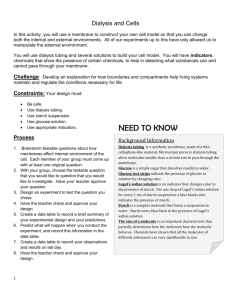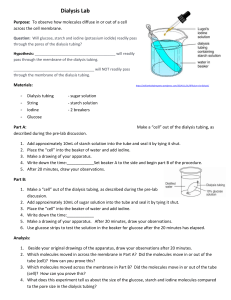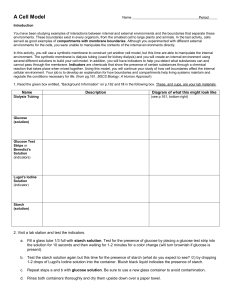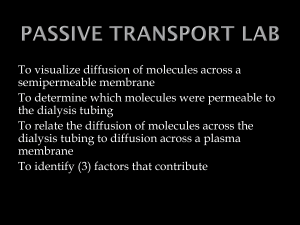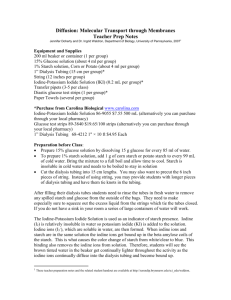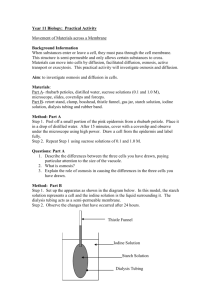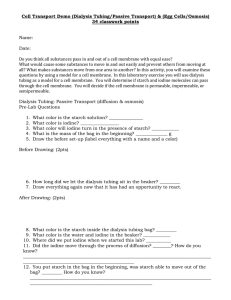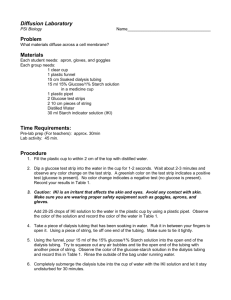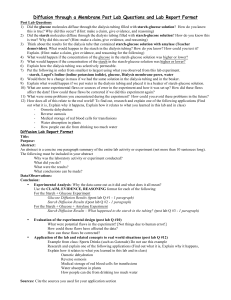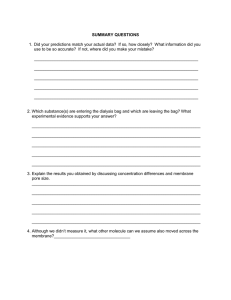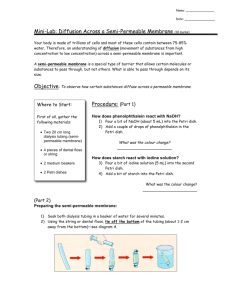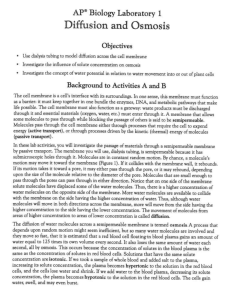A Cell Model PPT A Cell Model
advertisement
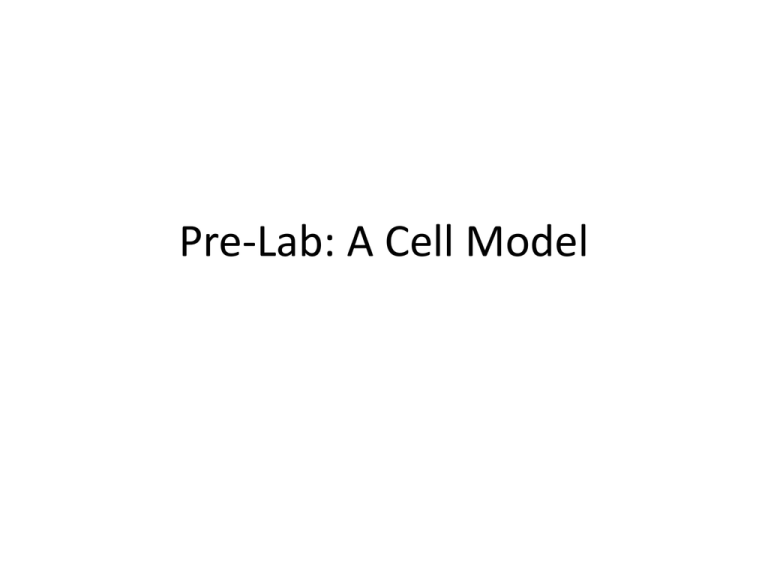
Pre-Lab: A Cell Model Lesson Target • I can explain how boundaries and compartments help living systems maintain and regulate the conditions necessary for life. Vocabulary • Indicators- Chemicals that show the presence of certain chemicals, to help in detecting what substances can and cannot pass through the membrane. • Protocol- Steps for carrying out an experiment- PROCEDURES Vocabulary • Dialysis Tubing- A synthetic membrane made of a thin cellophane-like material. Microscopic pores allow certain sized substances to pass through. • Glucose- a simple sugar that readily dissolves in water. Vocabulary • Lugol’s Iodine solution- an indicator that turns blue-black in the presence of starch. • Starch- A complex molecule that forms a suspension in water. Turns blue-black in the presence of iodine. • Benedicts Solution- A second test for glucose. Turns orange when heated. Testable Question • How does the size of a molecule affect its ability to pass through a membrane? Hypothesis • The smaller molecule will be able to pass through the membrane more easily than the larger molecules, because the membranes pores need to be small to help regulate what substances can pass through the membrane in order to protect the cell. Materials List • • • • • • • Safety goggles Plastic pipettes Dialysis tubing Plastic cups Starch solution Glucose solution Distilled water • • • • • • • Lugol’s Iodine solution Glucose test strips Graduated cylinder Permanent marker Tubing clamps Paper towels Benedicts solution Variables • MV- The internal/ external environment of the “cell” • RV- The passage of molecules across the membrane. • CV’s- Amt. of solution in each model; Amt of solution in each environment; time allowed in each environment…etc. Procedures- Day 1 1. Wet the strip of dialysis tubing and tie a knot or use a clamp to secure one end of the tube. 2. Measure out the correct amt. of solution for the inside of the tube. Use the pipette to fill the tube. 3. Tie or clamp the second end of the model. Rinse and dry the model. 4. Mass the model and record in data table. Procedures 5. Fill one cup with the proper amt. of solution for the external environment. Label cup with NAMES, DATE, and PERIOD. 6. Place your model in the cup 7. Clean up your work station. Sanitize the counter, wash and dry all equipment. Wait at lab station for inspection. Procedures- Day 2 8. Take model out of cup. Rinse, dry, and record mass of model. 9. Test external environment for the presence of the cells internal solution using the appropriate indicator EX.- if starch was on the inside of the cell model use Lugol’s iodine to test the external environment for the presence of starch solution. Procedures- Day 2 10.Carefully open the contents of the cell model over a clean cup. Test the internal solution for the presence of the cell model’s external environment. EX. If glucose was used on the outside of the cell model use the glucose test strips or Benedicts to test for the presence of glucose. Record the data in the table. Procedures- Day 2 11. Clean and sanitize your work station. Wait at your lab station for inspection. Results/ Data Table 1. Data for cell model constructed using dialysis tubing Contents of internal environment Contents of external environment Initial mass (g) Final Mass (g) Change in Mass (g) Predicted changes with explanations Internal Environment External Environment Conclusion Write a conclusion that addresses the following: • A statement of the question you tested and the results you predicted • A description of your methods (how did you preform the experiment- including the materials you used. • A description of your results in a well-organized table. • An explanation of your experimental results that clearly explains how a cell membrane behaves as a barrier and how dialysis tubing serves as a model of a cell.
